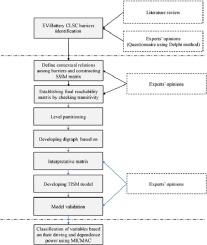Resources, Conservation and Recycling ( IF 13.2 ) Pub Date : 2021-06-28 , DOI: 10.1016/j.resconrec.2021.105751 Amir Hossein Azadnia , George Onofrei , Pezhman Ghadimi

|
End of life (EoL) management of the electric vehicles lithium-ion batteries (EVs-LIBs) has become a vital part of circular economy practices, especially in the European Union (EU). Consequently, manufacturers must develop EoL management of EVs-LIBs through reverse logistics (RLs) activities, which are bounded with many implementation barriers. Although several studies have been accomplished for RLs barrier analysis in various industries, less attention has been devoted to identifying and systematically analysing barriers of EVs-LIBs RLs. The purpose of this study is to identify a comprehensive list of the main barriers to the successful implementation of EVs-LIBs RLs practices. Based on the inputs from European industrial experts, an integrated approach of Total Interpretive Structural Modelling (TISM) and Cross-Impact Matrix Multiplication Applied to Classification (MICMAC) was applied to develop a hierarchical model based on the defined barrier categories. Finally, the most dominant barrier categories to the successful implementation of RLs activities for EVs-LIBs were prioritised to provide insights to industrial decision-makers and policymakers. Data were gathered using a questionnaire survey, which was distributed to various experts in EVs-LIBs manufacturing/recycling and EVs manufacturing companies. The findings revealed that ‘market and social’, and ‘policy and regulations’ categories are the two most influencing barriers to the implementation of EVs-LIBs RLs. This study lays the foundation for future research on the RLs activities for EVs-LIBs in a time that EU regulations on the circular economy are mandating all auto manufacturing companies to deal with their EoL wastes.
中文翻译:

电动汽车锂离子电池逆向物流实施障碍分析:一种TISM-MICMAC方法
电动汽车锂离子电池 (EVs-LIB) 的报废 (EoL) 管理已成为循环经济实践的重要组成部分,尤其是在欧盟 (EU)。因此,制造商必须通过逆向物流 (RL) 活动开发 EV-LIB 的 EoL 管理,这受到许多实施障碍的限制。尽管在各个行业中已经完成了一些关于 RLs 障碍分析的研究,但很少有人关注识别和系统地分析 EVs-LIBs RLs 的障碍。本研究的目的是确定成功实施 EVs-LIBs RLs 实践的主要障碍的综合清单。根据欧洲工业专家的意见,将总解释结构建模 (TISM) 和交叉影响矩阵乘法应用于分类 (MICMAC) 的集成方法应用于基于定义的障碍类别开发分层模型。最后,优先考虑成功实施 EV-LIB RLs 活动的最主要障碍类别,以便为工业决策者和政策制定者提供见解。数据是通过问卷调查收集的,问卷调查分发给 EV-LIB 制造/回收和电动汽车制造公司的各种专家。调查结果显示,“市场和社会”和“政策和法规”类别是影响 EV-LIBs RL 实施的两大障碍。



























 京公网安备 11010802027423号
京公网安备 11010802027423号